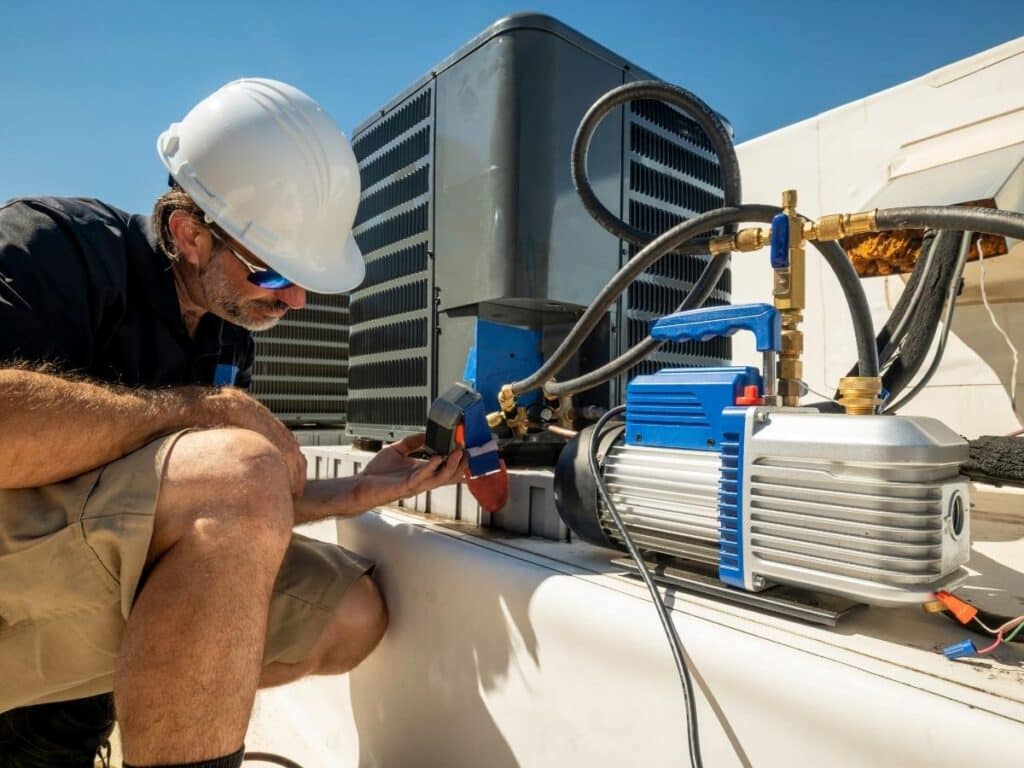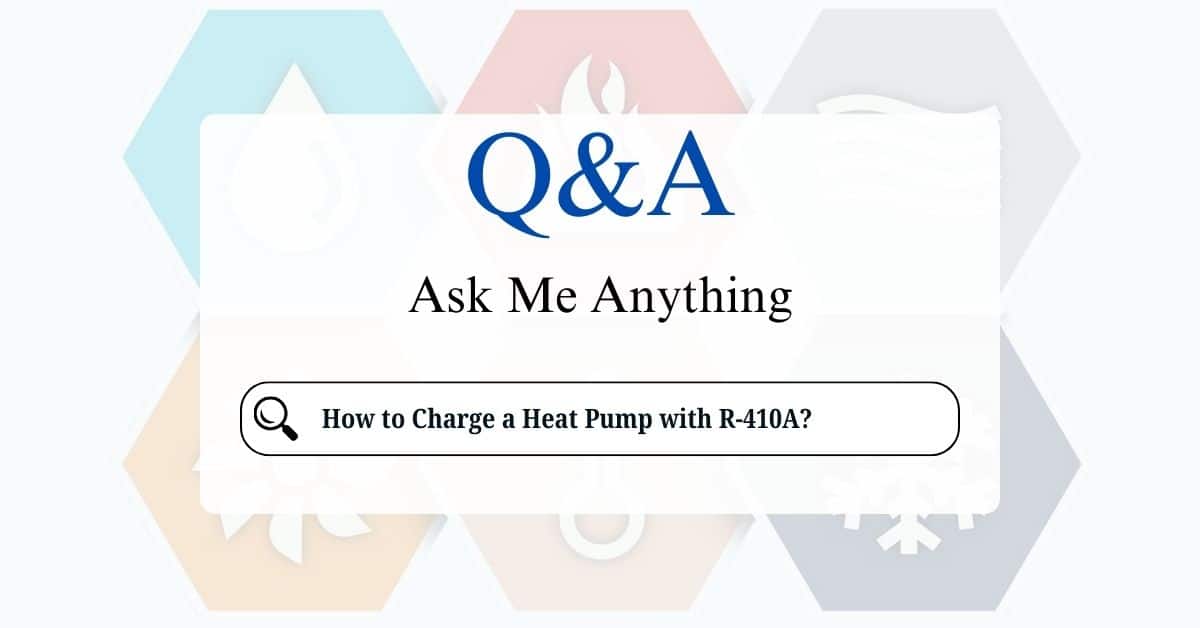Heat pumps are efficient and versatile systems that provide both heating and cooling. A key component of their operation is refrigerant, a substance that absorbs and releases heat. Many modern heat pumps use R-410A refrigerant. This guide will explain what “charging” a heat pump with R-410A means, why it’s a job for professionals, and what you should do if you suspect a refrigerant issue.
What is R-410A?
R-410A is a hydrofluorocarbon (HFC) refrigerant commonly used in heat pumps and air conditioners. It’s known for its efficiency and ability to absorb and release heat effectively. However, it’s important to note that R-410A is being phased out due to its high global warming potential. Newer refrigerants with lower environmental impact are being introduced.
How to “Charge” a Heat Pump?
Charging a heat pump with R-410A refrigerant is a precise and potentially hazardous process that requires proper tools, safety precautions, and HVAC certification (EPA Section 608). Here’s a step-by-step guide to help you understand the process.
1. Gather Necessary Tools and Materials
- R-410A refrigerant cylinder
- Manifold gauge set designed for R-410A
- Digital thermometer or clamp-on thermometer
- Refrigerant scale (to measure the refrigerant weight)
- Safety goggles and gloves
- EPA Section 608 certification (required for refrigerant handling)
2. Ensure Safety
- Turn Off Power: Shut off the power to the heat pump at the breaker panel.
- Wear Protective Gear: Use gloves and safety goggles to prevent exposure to refrigerant.
- Work in a Ventilated Area: Ensure the area around the heat pump is well-ventilated to prevent refrigerant accumulation.
3. Connect the Manifold Gauge Set
- Attach the Hoses:
- Connect the blue hose to the low-pressure (suction) service port on the heat pump.
- Connect the red hose to the high-pressure (discharge) service port.
- Attach the yellow hose to the refrigerant cylinder.
- Purge Air from the Hoses:
- Open the manifold valves slightly to allow refrigerant to push out any air trapped in the hoses.
4. Check System Pressures
- Turn on the Heat Pump:
- Set the thermostat to cooling mode and let the system stabilize for about 10–15 minutes.
- Monitor the Pressures:
- Check the low-side (suction) and high-side (discharge) pressures on the manifold gauge.
- Compare the readings to the manufacturer’s pressure-temperature chart for R-410A.
5. Add Refrigerant
- Weigh the Refrigerant:
- Place the refrigerant cylinder on a scale to monitor the amount being added.
- Introduce Refrigerant Slowly:
- Open the low-pressure valve on the manifold gauge set slightly to allow refrigerant to flow into the system.
- Add refrigerant in small increments to avoid overcharging.
- Monitor Temperatures:
- Use a thermometer to measure the suction line temperature.
- Ensure the system’s superheat or subcooling values match the manufacturer’s specifications.

6. Achieve Correct Charge
- Subcooling (Cooling Mode):
- Measure the liquid line temperature and compare it to the saturation temperature from the pressure-temperature chart.
- Adjust refrigerant until the subcooling matches the manufacturer’s recommended value (typically 8–12°F).
- Superheat (Heating Mode):
- Measure the suction line temperature and compare it to the saturation temperature.
- Adjust refrigerant to achieve the proper superheat value (typically 10–15°F).
7. Test the System
- Allow the heat pump to run for an additional 10–15 minutes to stabilize.
- Recheck the pressures, temperatures, and superheat/subcooling values to ensure proper operation.
8. Disconnect the Gauges
- Turn Off the Heat Pump:
- Shut off the system at the thermostat and circuit breaker.
- Remove the Hoses:
- Disconnect the hoses from the service ports.
- Replace the service port caps tightly to prevent leaks.
9. Record the Refrigerant Amount
- Note the amount of refrigerant added for future reference and maintenance records.
Why You Shouldn’t DIY Refrigerant Charging
Handling refrigerant, especially R-410A, is not a DIY task. Here’s why:
- EPA Regulations: The Environmental Protection Agency (EPA) regulates the handling of refrigerants like R-410A. Technicians must be certified to purchase and handle these substances.
- Specialized Equipment: Accurate refrigerant charging requires specialized tools like manifold gauges, vacuum pumps, and refrigerant recovery equipment.
- Safety Hazards: Improper handling of refrigerant can cause frostbite and other health issues. Mixing different refrigerants or introducing air into the system can also damage the equipment.
- Environmental Concerns: Releasing refrigerant into the atmosphere contributes to climate change. Certified technicians are trained to recover and recycle refrigerant properly.
What to Do If You Suspect a Refrigerant Issue
If you notice any of these signs, the correct course of action is to contact a qualified HVAC technician. They have the expertise, equipment, and certifications to:
- Accurately Diagnose the Problem: They will perform a thorough inspection to determine if a refrigerant leak is the cause of the issue.
- Locate and Repair the Leak: If a leak is found, they will locate the source and repair it properly.
- Recover and Recycle Refrigerant: They will recover any remaining refrigerant in the system and recycle it according to EPA regulations.
- Properly Charge the System: They will add the correct amount of refrigerant to restore the system’s optimal performance.
Maintaining Your Heat Pump to Prevent Refrigerant Issues
Regular maintenance can help prevent refrigerant leaks and other problems:
- Annual Professional Tune-Ups: Schedule annual professional maintenance for your heat pump. During a tune-up, the technician will inspect for leaks, check refrigerant pressure, clean the coils, and ensure all components are working correctly.
- Regular Air Filter Changes: Dirty air filters restrict airflow, which can put stress on the system and potentially contribute to leaks. Change your filters every 1-3 months.
- Keep the Outdoor Unit Clean: Ensure the area around the outdoor unit is clear of debris and vegetation.
Key Takeaways about R-410A and Heat Pump Charging:
- “Charging” a heat pump means adding refrigerant, which is only necessary if there’s a leak.
- Handling R-410A refrigerant is not a DIY task due to EPA regulations, safety hazards, and the need for specialized equipment.
- If you suspect a refrigerant issue, contact a qualified HVAC technician.
- Regular maintenance can help prevent refrigerant leaks and other problems.
By understanding these points and leaving refrigerant handling to the professionals, you can ensure your heat pump operates efficiently and safely for years to come.






